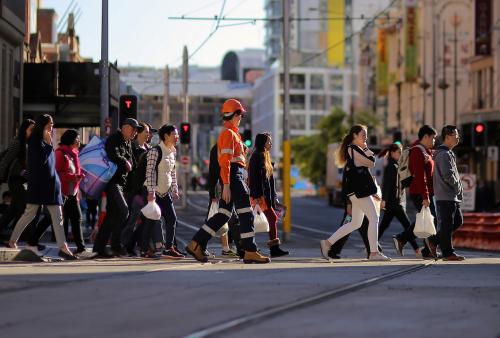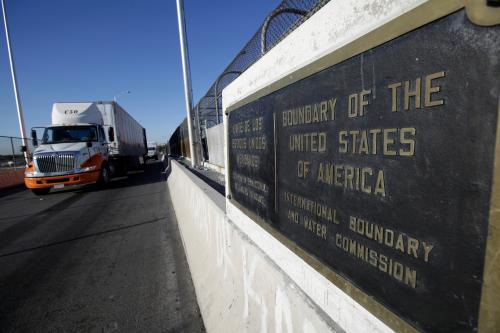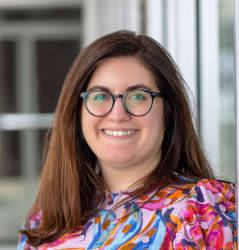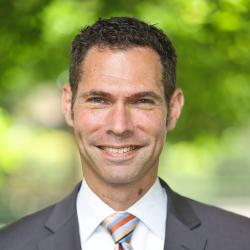A large German corporation intrigued by a proprietary technology developed by a local firm in a mid-size U.S. market makes a winning bid for the company. Foreign executives arrive in town to assume management over the company and evaluate how its divisions and employees could be integrated into the larger firm. For local leaders, a tantalizing prospect beckons: new foreign investment to upgrade the decades-old factory and hire more scientists and engineers; the prospect of collaborating on an apprenticeship program and gaining world-class expertise that could spill over into the entire community, boosting local ambitions to evolve the region into a knowledge capital; and greater access to the German firm’s existing trade networks across the European market, adding to new local jobs and growth.
Yet danger also lurks. Could the foreign firm simply be interested in acquiring the technology, before shifting operations to its other U.S. subsidiary in a coastal city with more R&D-intensive universities and a stronger supply chain, not to mention better weiner schnitzel and a direct flight to Hamburg? Is this deal really going to turn into a local win, after all?
Answering that question and ensuring that foreign investment turns into tangible gains over the long term is the crux of strategic metropolitan foreign direct investment (FDI) practice. As part of that, local economic development leaders must ensure that foreign firms have access to the resources they need over time to succeed and ultimately prove their value to ruthlessly efficient executives with little loyalty to the community, reviewing balance sheets thousands of miles away. That can mean a strong pipeline of skilled workers, innovation assets, and other characteristics of a sophisticated cluster comparable to that of the firm’s home country. It can also mean exhibiting cultural openness, ensuring foreign executives and workers feel welcome in a new region that may be fundamentally different than their headquarters, and helping newcomers establish credit, apply for a driver’s license, and navigate other logistical hurdles involved in moving to the U.S.
“If you have a foreign entity coming into the Atlanta region and acquiring a local company, they may not necessarily have a wealth of knowledge about the ecosystem here in metro Atlanta,” said Natalie Jones, a manager of global programs at the Metro Atlanta Chamber (MAC), who spearheads the region’s FDI strategy. “So I try to get in front of that foreign entity to do a ‘why Atlanta’ pitch to make sure that they know the different resources that could help them.”
At its most basic form, aftercare resembles business retention & expansion practices (BR&E), meeting with and probing firms on their challenges and needs to remain loyal and add more jobs and investment to the region. For an economic development organization, that process starts with understanding the market, filling gaps in awareness of local foreign firms, and building the capacity for region-wide service delivery.
Responding to the fact that 60 percent of FDI in metro Atlanta is a result of foreign M&A transactions, leaders at the MAC mined data on local firms to pinpoint foreign companies, providing state and local partners with detailed, ongoing market intelligence on firms to engage in their jurisdictions and guiding MAC’s own outreach. MAC also convened an Aftercare Task Force made up of industry leaders and service providers, delivering a mechanism to funnel leads and requests for local expertise and assistance to relevant parties.
MAC has also made a point of engaging executives at the overseas headquarters of some firms, reflecting the fact that decisions about local jobs and investment are now in the hands of people far away from the region. In one instance, meeting with a foreign firm on an existing trip to India allowed leaders to get ahead of a consolidation of U.S. subsidiaries, educating the firm on the region’s local ecosystem and laying groundwork for a potential expansion in the Atlanta region.
Similar approaches have helped CenterState CEO, an economic development organization in Central New York, address challenges faced by foreign firms. Leaders there reach out to new foreign firms twice annually, including integrating outreach into existing exports assistance programming. These conversations have surfaced common challenges shared by locally owned firms, unique circumstances that CenterState CEO has been able to help resolve, and leads on potential expansions. After learning about a shared problem around shipping, leaders connected two different foreign-owned food manufacturers to work together to address the challenge and share other resources and equipment. As firms across the region feel the pinch for high- and mid-skill talent, CenterState CEO has also been deliberate about including foreign firms in a talent analysis aimed at building new collaborations and programs to ensure a stronger regional talent pipeline.
Atlanta and Central New York are only two of the regions strengthening their approach to maximizing the value of foreign investment through the Global Cities Exchange. Others have outlined plans to establish a “Welcome Network” to engage new international arrivals, develop a service provider directory to routinize contact, and set goals for surveys and regular company meetings. Beyond the corner Bierhaus and local sushi restaurant, these efforts are important steps to ensure that foreign firms feel welcome—and thus regions enjoy the benefits of their investment long into the future.
Thanks to Noah Nelson for helpful assistance in preparing this post.
The Brookings Institution is committed to quality, independence, and impact.
We are supported by a diverse array of funders. In line with our values and policies, each Brookings publication represents the sole views of its author(s).







Commentary
FDI: The art of (after) the deal
May 24, 2018